Interrogation.
Just the word elicits your vision of forcible confinement in a hot and windowless room, shoved in a wooden chair with one leg shorter than others, a bright light from a bare bulb burning over your head, and hulking forms of trench-coated detectives firing hardboiled questions in your face.
The truth is different. A lot different. There’s a high skill involved in getting useful (and courtroom admissible) information from people, and not everyone is cut out for the job. Are you? Would you be a good police interrogator?
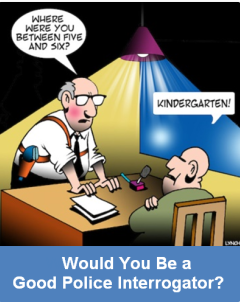 To start, drop the “interrogation” word. It’s not correct to say “interrogation” in today’s professional police procedures. The right terms are “interview” and “dialogue exchange”. And, they’re more applicable because the vast majority of police-civilian interactions are respectful interchanges of relevant information.
To start, drop the “interrogation” word. It’s not correct to say “interrogation” in today’s professional police procedures. The right terms are “interview” and “dialogue exchange”. And, they’re more applicable because the vast majority of police-civilian interactions are respectful interchanges of relevant information.
I’ve spent a good part of my adult life talking to people and getting information. I learned long ago that you get more bees with honey than you do with vinegar. I also learned you slide a lot further on bullshit than you do on gravel. I made those principles the core of my information-gathering days. I also practiced another fundamental rule. That’s that the best interrogators interviewers are the best listeners.
Where’s this going? I subscribe to Psychology Today. I recently read a piece by Mary Ellen O’Toole, Ph.D. in her regular column Criminal Minds where she set out ten questions with graded responses to her Are You A Good Listener Test. Dr. Mary Ellen O’Toole was a senior profiler at the FBI’s Behavioral Analysis Unit and author of Dangerous Instincts: How Gut Feelings Betray Us. Here’s her short ten-question exam to see if you would be a good police interrogator. Sorry… police interviewer.
ARE YOU A GOOD LISTENER TEST
1.Typically, how emotional (frightened, insecure, angry, etc.) do I get when I am attempting to interview someone? (Rate this on a scale of 1-3)
1 = very emotional
2 = nonemotional and detached
3 = I remain interested and tempered
2. Typically, how often do I interrupt?
1 = several times during a conversation
2 = just once or twice during a conversation
3 = almost never
3. Do I say things like “What? You have got to be kidding me,” – or- “That reminds me of the time I…” – or – “You think that’s bad, let me tell you about…”
1 = frequently
2 = sometimes
3 = rarely
4. Do I roll my eyes, put my head down, shake my head back and forth, throw myself back in my chair, turn away, get up and walk away, show signs of anger or threatening behavior, or otherwise display that I am not paying attention or do not like what the other person is saying?
1 = frequently
2 = sometimes
3 = rarely
5. Do I fidget until people stop talking and then immediately respond without considering what they’ve said?
1= frequently
2 = sometimes
3 = rarely
6. Do I let my mind wander to all the other things on my “to do” list and keep thinking that I just don’t have the time for this?
1 = frequently
2 = sometimes
3 = rarely
7. Do I wait until the nanosecond when the speaker goes to take a breath to pounce on him or her with my opinions?
1 = frequently
2 = sometimes
3 = rarely
8. Do I hijack the conversation? For instance by saying something like, “Look we’ve been over this a million times. Your ideas are just not going to work. This is what we are going to do.”
1 = frequently
2 = sometimes
3 = rarely
9. I reflect the person’s thoughts and feelings back to the person I am listening to.
1 = rarely
2 = sometimes
3 = frequently
10. I ask open-ended questions to encourage the other person to talk.
1 = rarely
2 = sometimes
3 = frequently
Total Score = ______
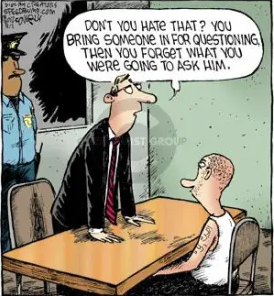 The higher the score – the better your listening skills tend to be and the better interrogator interviewer you would be. Note: This is not a scientific test and has not been validated or otherwise vetted. These opinions are those of Dr. O’Toole and do not represent the views of the FBI.
The higher the score – the better your listening skills tend to be and the better interrogator interviewer you would be. Note: This is not a scientific test and has not been validated or otherwise vetted. These opinions are those of Dr. O’Toole and do not represent the views of the FBI.
My experience is that the key to successful information gathering is simply listening to what’s being said. Does it make sense? Does it fit? Does it make you ask more questions? Or does what’s being said to you satisfy what you’re after? Another Note: Police interviews/dialogue exchanges are all about getting the truth. Contrary to conspiracy theories, no good cop wants a false confession.
Kill Zoners – Let us know how you scored on the test!

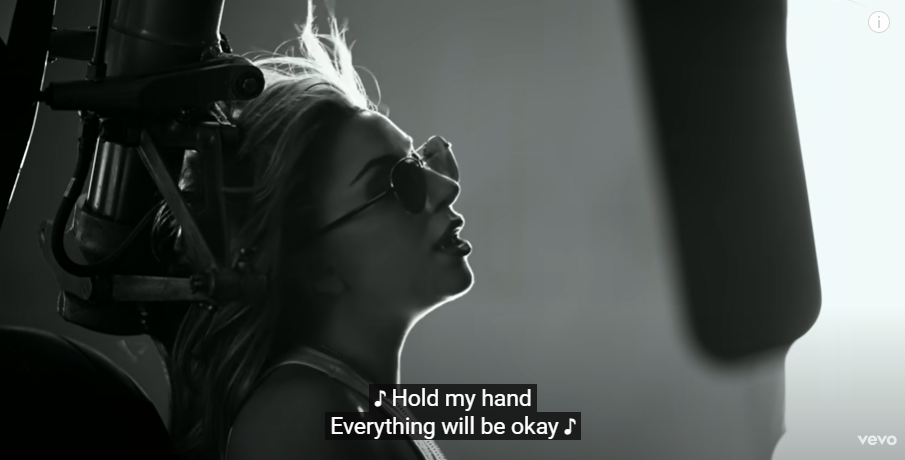
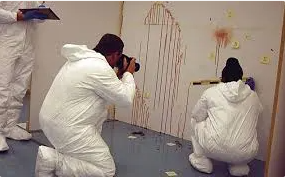 You’ve seen the CSI shows where investigators, dressed in their ‘bunny suits’, photograph drops, streaks, smears, and pools of blood, then swab for DNA and String the room back to Area of Convergence points. Well, that’s pretty much how it happens, except today most Stringing is done by 3D computerization.
You’ve seen the CSI shows where investigators, dressed in their ‘bunny suits’, photograph drops, streaks, smears, and pools of blood, then swab for DNA and String the room back to Area of Convergence points. Well, that’s pretty much how it happens, except today most Stringing is done by 3D computerization.
 Single Drop — These stains are typically from a vertical fall and under low velocity, like when your cut your finger and blood drips to the floor. Blood molecules are very cohesive. They attract and bind in a surface tension that makes a sphere. The drop stays in a ball until it strikes an object or a force acts on it. This is called bleed-out.
Single Drop — These stains are typically from a vertical fall and under low velocity, like when your cut your finger and blood drips to the floor. Blood molecules are very cohesive. They attract and bind in a surface tension that makes a sphere. The drop stays in a ball until it strikes an object or a force acts on it. This is called bleed-out.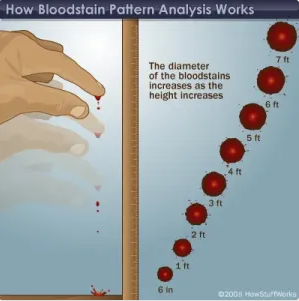

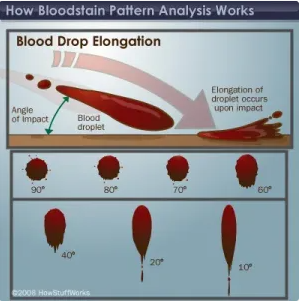
 Transfer Bloodstains — These are generally patches and smears of blood deposited secondary to the main, violent event. They say a lot about sequence. It can be when a victim tried to crawl away, the body was dragged, the perpetrator placed a bloody hand on a wall, or when he hid the axe in a closet like Billy Ray did. Tell you more about him soon.
Transfer Bloodstains — These are generally patches and smears of blood deposited secondary to the main, violent event. They say a lot about sequence. It can be when a victim tried to crawl away, the body was dragged, the perpetrator placed a bloody hand on a wall, or when he hid the axe in a closet like Billy Ray did. Tell you more about him soon. Insect Stains — Not long after death, the bugs show up. They land in the bloodstains and make little tracks all over the place. These are easily confused with HVIS to the untrained eye and known in the industry as Flyspeck.
Insect Stains — Not long after death, the bugs show up. They land in the bloodstains and make little tracks all over the place. These are easily confused with HVIS to the untrained eye and known in the industry as Flyspeck.
 It took us three days to catch Billy Ray. He did the right thing and fessed-up, then re-enacted the murders on video. It was the coldest thing I’ve seen. Billy Ray described what he did as if he were watching Jason or The Shining, going through repeated motions of chopping, and back-swinging, and chopping some more. He demonstrated with a 2×2 stick as a prop. (We were nervous about giving him a real axe.) He showed how he modified body positions after death, where he hid his axe in the closet, and where he cleaned himself up.
It took us three days to catch Billy Ray. He did the right thing and fessed-up, then re-enacted the murders on video. It was the coldest thing I’ve seen. Billy Ray described what he did as if he were watching Jason or The Shining, going through repeated motions of chopping, and back-swinging, and chopping some more. He demonstrated with a 2×2 stick as a prop. (We were nervous about giving him a real axe.) He showed how he modified body positions after death, where he hid his axe in the closet, and where he cleaned himself up. “Hypnosis is a natural state of consciousness that we drift in and out of quite regularly. For example, while driving along a highway and then suddenly discovering that you ‘lost’ several miles without being aware of it. This can also happen during reading when you may notice that you have ‘read’ a chapter or two without being mindful of the content. Hypnosis is basically a technique for focusing consciousness by entering a deep state of absorption. It allows you to shift from your outer to inner awareness and tap deeper levels of consciousness so we can re-educate and reprogram the subconscious with empowering suggestions or beliefs.”
“Hypnosis is a natural state of consciousness that we drift in and out of quite regularly. For example, while driving along a highway and then suddenly discovering that you ‘lost’ several miles without being aware of it. This can also happen during reading when you may notice that you have ‘read’ a chapter or two without being mindful of the content. Hypnosis is basically a technique for focusing consciousness by entering a deep state of absorption. It allows you to shift from your outer to inner awareness and tap deeper levels of consciousness so we can re-educate and reprogram the subconscious with empowering suggestions or beliefs.”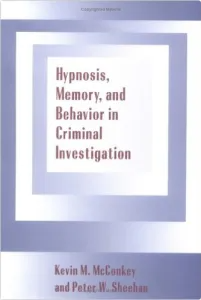 “Hypnosis,” says Kevin McConkey, President of the Australian Psychological Society and co-author of Hypnosis, Memory, and Behavior in Criminal Investigation, “is essentially a phenomenon that reflects genuinely experienced alterations of reality in response to suggestions administered by a hypnotist. The subject’s testimony is what confirms the trance, although susceptibility varies among individuals. Those who are highly suggestive will behave as if going through truly significant cognitive alterations.”
“Hypnosis,” says Kevin McConkey, President of the Australian Psychological Society and co-author of Hypnosis, Memory, and Behavior in Criminal Investigation, “is essentially a phenomenon that reflects genuinely experienced alterations of reality in response to suggestions administered by a hypnotist. The subject’s testimony is what confirms the trance, although susceptibility varies among individuals. Those who are highly suggestive will behave as if going through truly significant cognitive alterations.”
 In wintery April, an elderly lady in her 70s was alone in her cabin on a remote gold claim in northern British Columbia. A masked man with a handgun appeared at her door, demanding she hand over her gold stash. She refused. He proceeded to blindfold and hog-tie her, then began torturing by burning her hands and ribs with a red-hot knife heated on her wood stove.
In wintery April, an elderly lady in her 70s was alone in her cabin on a remote gold claim in northern British Columbia. A masked man with a handgun appeared at her door, demanding she hand over her gold stash. She refused. He proceeded to blindfold and hog-tie her, then began torturing by burning her hands and ribs with a red-hot knife heated on her wood stove. Now knowing an accomplice was involved, we focused the investigation on a neighbor who’d been involved with a gold claim boundary dispute. We identified the suspect as a Hells Angels striker who’d been hired by the neighbor, so we ran a wiretap which caught him using the term ‘squirreled away’. This led to an elaborate, clandestine sting operation resulting in his confession to an undercover agent. He was convicted and got twenty years.
Now knowing an accomplice was involved, we focused the investigation on a neighbor who’d been involved with a gold claim boundary dispute. We identified the suspect as a Hells Angels striker who’d been hired by the neighbor, so we ran a wiretap which caught him using the term ‘squirreled away’. This led to an elaborate, clandestine sting operation resulting in his confession to an undercover agent. He was convicted and got twenty years.
 Garry Rodgers is a retired homicide detective with a second career as a coroner. Now, Garry reincarnated as a crime writer with a popular blog at
Garry Rodgers is a retired homicide detective with a second career as a coroner. Now, Garry reincarnated as a crime writer with a popular blog at 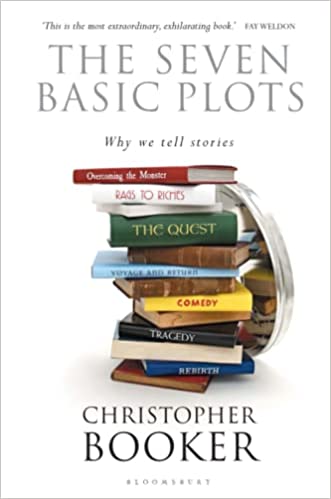





 Garry Rodgers is a retired homicide detective and coroner. Now, he’s reincarnated as an indie crime writer who’s left the dark side of Amazon exclusivity for the wide light of other publishing platforms like Kobo, Apple, and Nook.
Garry Rodgers is a retired homicide detective and coroner. Now, he’s reincarnated as an indie crime writer who’s left the dark side of Amazon exclusivity for the wide light of other publishing platforms like Kobo, Apple, and Nook.

 It feels like this: it’s a big mountain, full of mud. It’s raining. Hard. I’m carrying this heavy weight. But I’ve got this! It’s just that some days it’s just…so exhausting. Or I have a migraine. Or I’m running my kids around (single mom). Or I’ve got client deadlines (solopreneur).
It feels like this: it’s a big mountain, full of mud. It’s raining. Hard. I’m carrying this heavy weight. But I’ve got this! It’s just that some days it’s just…so exhausting. Or I have a migraine. Or I’m running my kids around (single mom). Or I’ve got client deadlines (solopreneur). As a survivor of
As a survivor of  Rachel Thompson released the
Rachel Thompson released the 
 My definite purpose—my wanna—is creating the series titled City Of Danger. It’s a concept long brewing in my mind but activated by a chance opportunity with the film industry. I committed to City Of Danger on April 7, 2021 and steadily worked on developing it for the last ten months. I expect the pilot episode releasing this summer.
My definite purpose—my wanna—is creating the series titled City Of Danger. It’s a concept long brewing in my mind but activated by a chance opportunity with the film industry. I committed to City Of Danger on April 7, 2021 and steadily worked on developing it for the last ten months. I expect the pilot episode releasing this summer.